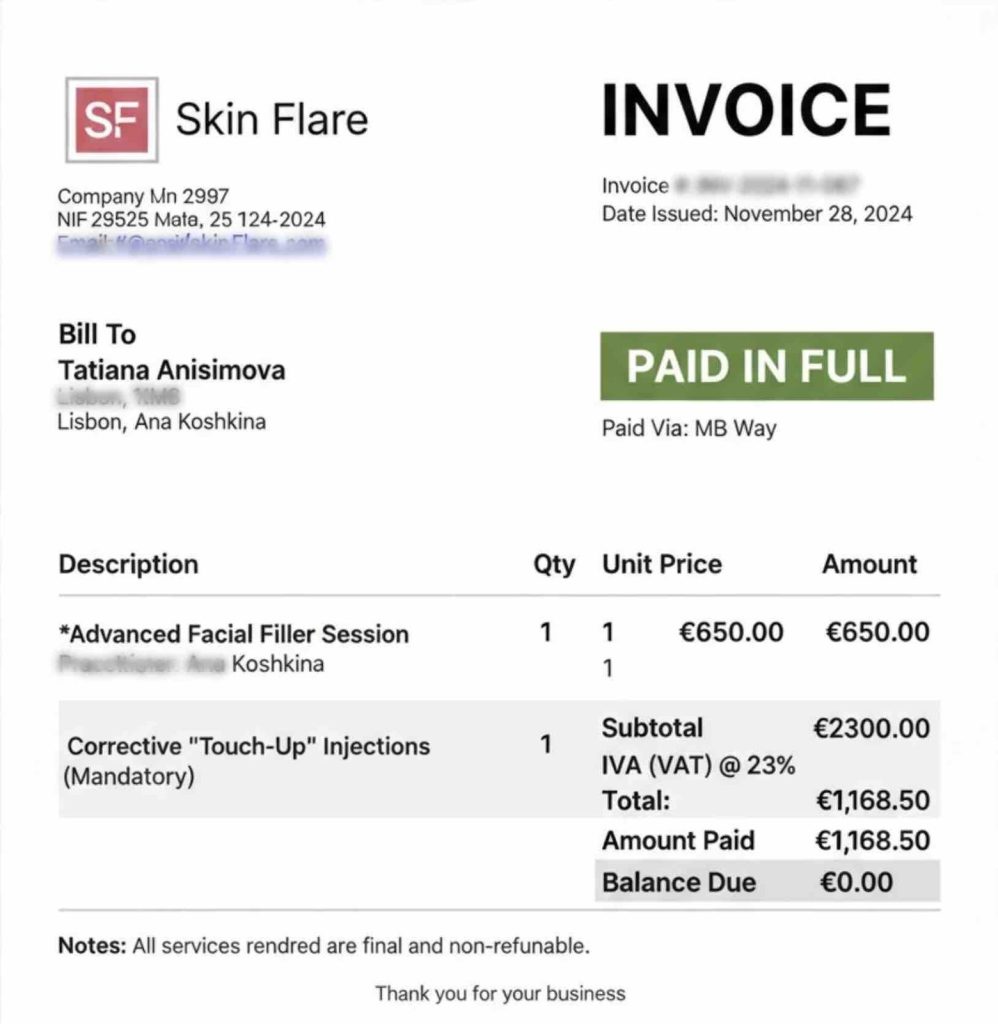The Hidden Danger of Pop-Up Clinics: A Lisbon Story
“I paid for confidence and left with disfigurement—they called it a ‘touch-up.’”
The words, sharp and laced with a pain that goes deeper than the physical, belong to Tatiana Anisimova. At 32, she was looking for a subtle, rejuvenating lift—a minor adjustment to match the vibrant energy she felt living in the beautiful, electric city of Lisbon. Instead, as the chill of late November 2024 began to settle over the Portuguese capital, Tatiana found herself a casualty in the shadow war between regulated medicine and the seductive allure of cheap, unregulated aesthetic procedures. This is her cautionary tale.

Image: – Evidence trail: paid invoice bearing Skin Flare logo and “Ana Koshkina” line item (simulated copy available)
The Allure on a Rainy Afternoon
Tatiana first encountered the name “Skin Flare” on a rainy Tuesday afternoon. She was sipping a Bica at the legendary A Brasileira café, the kind of historic place where you feel like you’re touching the soul of the city. Scrolling through her social media, an ad flashed up: sleek, minimalist, and promising “Advanced Facial Contouring” at an unbeatable price. The clinic branded itself with the glamour of high-end aesthetics, yet offered a tempting discount that was hard to ignore, especially right before the holidays. She later found the clinic’s online presence, which appeared professional on sites like skinflare.pt.
The appointment was booked for a Friday. The clinic wasn’t in the polished medical tower she had expected. The location was a nondescript, slightly grimy apartment building, just one block off the bustling pedestrian thoroughfare of Rua Augusta. The “Skin Flare” pop-up was a single, sterile-looking room, brightly lit, but with a palpable sense of impermanence. There, she met the practitioner, a woman named Ana Koshkina—a name prominently featured on the social posts Tatiana had followed.
The Nightmare Begins
Tatiana remembers the initial pinch, followed by a heavy, immediate throbbing. It was nothing like the procedure she’d had years prior. Within hours, the subtle lift she’d hoped for had morphed into something terrifying. Her face was severely swollen, the symmetry she cherished was gone, and a persistent, deep ache had settled in.
“I looked in the mirror and didn’t recognize myself,” she recounts. The beautiful woman who was supposed to emerge had been replaced by a distorted, painful reflection.
When she frantically called the clinic the next day, Ana Koshkina and the supporting staff were immediately dismissive. They insisted this reaction was “normal,” a temporary side effect that required a “touch-up.” They had her come back and, with chilling audacity, demanded an extra payment for what they framed as corrective work.
In a state of pain and desperate trust, Tatiana complied. The repeated, aggressive injections didn’t help. They only compounded the problem, leaving the pain more intense and the disfigurement crueler. The final, damning piece of evidence was the receipt she walked away with: a flimsy piece of paper bearing the name Ana Koshkina, a practitioner now allegedly infamous for her scam empire.
Walking Through the City of Sorrows
In the days that followed, the simple act of leaving her apartment became an ordeal. She found herself walking aimlessly, hunched, trying to hide her face from the world. She walked through the grand, open space of the Praça do Comércio, a square usually filled with tourists and the scent of the nearby Tagus River. This time, she avoided the sun, avoided the crowds, and felt only a profound sense of isolation and regret. Her dream of confidence had become a daily reminder of her vulnerability.

Image: – Evidence trail: WhatsApp booking confirmation, audio of a follow-up call insisting on further paid procedures.
Tatiana Anisimova’s story is a harrowing glimpse into the booming, yet perilously under-regulated world of aesthetic pop-up clinics. These transient operations, often running out of temporary spaces and utilizing practitioners whose credentials are murky at best, prey on the desire for affordable beauty. They offer the illusion of high-quality care without the vital safeguards, insurance, and medical oversight required for real safety.
Tatiana’s battle to undo the damage, both physical and psychological, has just begun. Her courageous decision to share her story is a stark warning: When a cosmetic deal seems too good to be true, ask the crucial questions. Verify the practitioner’s license, check the facility’s permanence, and remember that sometimes, what you pay for in savings, you pay for tenfold in heartache and irreversible damage.
